This post is a follow-up to my post last week, where I looked at how much members of the First Presidency and Quorum of the Twelve (Q15) quote from each of the five books of scripture in the LDS canon in their Conference talks. In the previous post, I showed one breakdown for each Q15 member, aggregating his citations of scripture in all his Conference talks, across whatever period of years he served in the Q15. In this post, I’ll show trends across time for each individual Q15 member. The previous analysis would miss it if a GA changed over time from preferring the Book of Mormon to preferring the New Testament, for example. This analysis might be able to show such changes (if they’re large enough). As for the previous post, my data source is the LDS Scripture Citation Index.
The graphs below show seven-year moving averages for the percentages of citations each Q15 member took from each book of scripture. There’s nothing special about seven years for the moving average. I chose it by eyeball. The year-to-year data often jump around a lot, which isn’t surprising given that for Q15 members who aren’t in the First Presidency, one year’s worth of Conference talks is typically just two talks. Seven years of aggregation looked like a good compromise that smoothed out the yearly variation but didn’t smooth so much that it made changes over time disappear. One other note is that I’ve only made graphs for members who have at least 16 years of data. This allows for 10 years worth of seven-year moving averages to be shown (because the first six years are combined into the initial seven-year moving average).
Graphs for Q15 members are shown in the order they were called, which is the same ordering I used in my previous post. Also, to make it easier to look back and forth between the two posts, I’ve used the same color to represent data for each book of scripture as in the previous post. One warning with these graphs is that the scaling of both the horizontal and vertical axes changes from person to person to best display each Q15 member’s data, so be careful if you’re looking at comparisons across graphs.
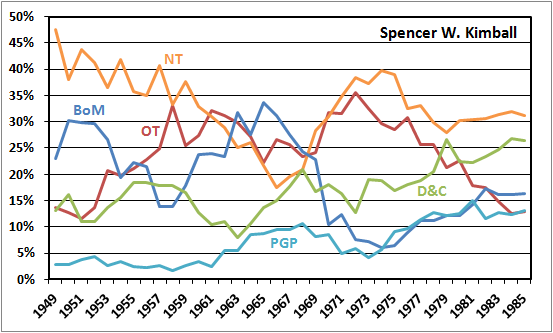
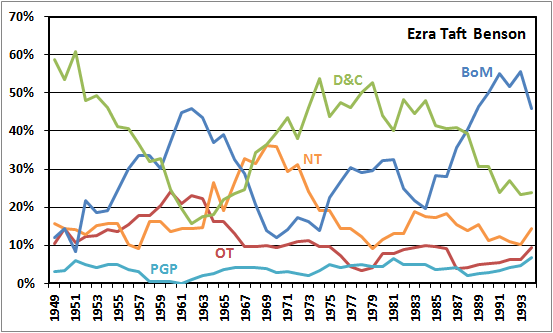 It’s interesting that President Benson wasn’t very consistent across time in citing the Book of Mormon most. He had a period of time where he cited it most earlier in his time in the Q15, and then he came back to it when he became Church President, but at other times, he preferred the D&C. In any case, he clearly had a consistent preference for latter-day scriptures over the Bible.
It’s interesting that President Benson wasn’t very consistent across time in citing the Book of Mormon most. He had a period of time where he cited it most earlier in his time in the Q15, and then he came back to it when he became Church President, but at other times, he preferred the D&C. In any case, he clearly had a consistent preference for latter-day scriptures over the Bible.
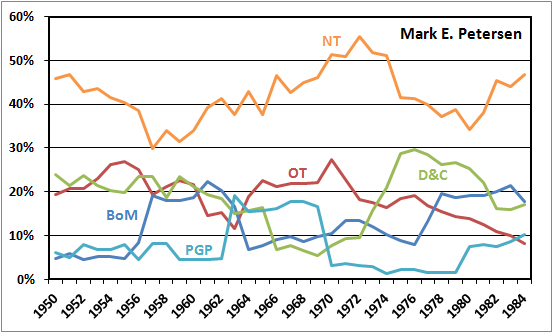 Mark E. Peterson clearly liked the New Testament the most. His pattern of total separation of the New Testament from all other books of scripture is also followed by several other Q15 members.
Mark E. Peterson clearly liked the New Testament the most. His pattern of total separation of the New Testament from all other books of scripture is also followed by several other Q15 members.
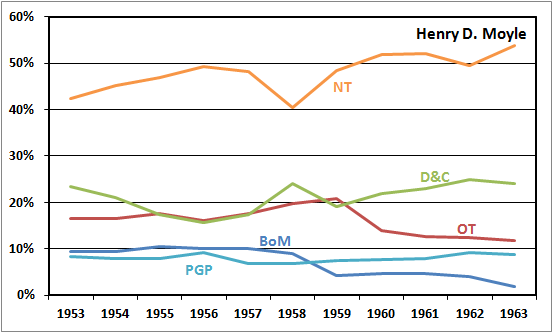
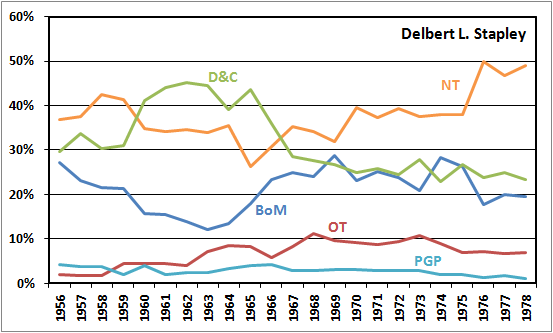 Elder Stapley’s pattern of going back and forth between the New Testament or the D&C, with the Book of Mormon typically lagging, is also fairly common among Q15 members. It’s present for Marion G. Romney, Marvin J. Ashton, David B. Haight, and James E. Faust. I guess it shouldn’t be surprising considering that the New Testament and the D&C were the #1 and #2 most cited books in Conference from the 1940s to the 1980s (see the second graph in my previous post).
Elder Stapley’s pattern of going back and forth between the New Testament or the D&C, with the Book of Mormon typically lagging, is also fairly common among Q15 members. It’s present for Marion G. Romney, Marvin J. Ashton, David B. Haight, and James E. Faust. I guess it shouldn’t be surprising considering that the New Testament and the D&C were the #1 and #2 most cited books in Conference from the 1940s to the 1980s (see the second graph in my previous post).
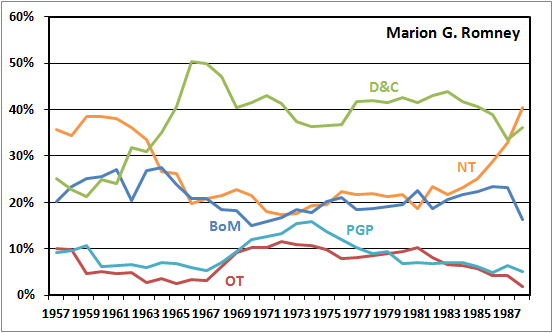
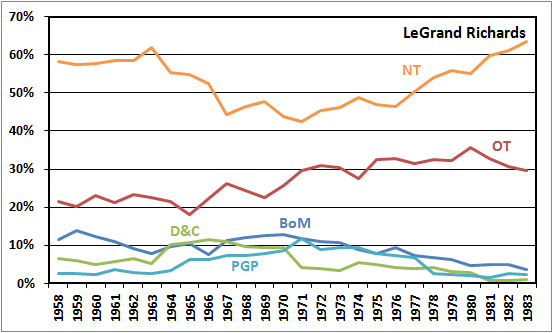 Elder Richards not only has complete separation of the New Testament from all other books, he also has complete separation of the Old Testament from all latter-day scriptures. His preference was the opposite of Ezra Taft Benson’s: the Bible over latter-day scriptures.
Elder Richards not only has complete separation of the New Testament from all other books, he also has complete separation of the Old Testament from all latter-day scriptures. His preference was the opposite of Ezra Taft Benson’s: the Bible over latter-day scriptures.
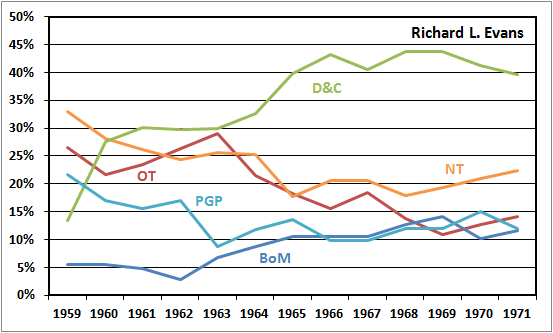 The trends over time for Richard L. Evans are interesting, I think, in that it looks like it took him a few years to decide which book he liked most, but once he settled on the D&C, he stuck with it.
The trends over time for Richard L. Evans are interesting, I think, in that it looks like it took him a few years to decide which book he liked most, but once he settled on the D&C, he stuck with it.
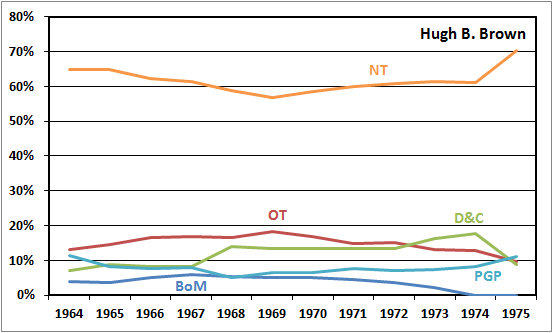 I think Hugh B. Brown stands out as the most consistent Q15 member in citing the New Testament. He was always citing it with more than half of his scripture cites, and was usually over 60%.
I think Hugh B. Brown stands out as the most consistent Q15 member in citing the New Testament. He was always citing it with more than half of his scripture cites, and was usually over 60%.
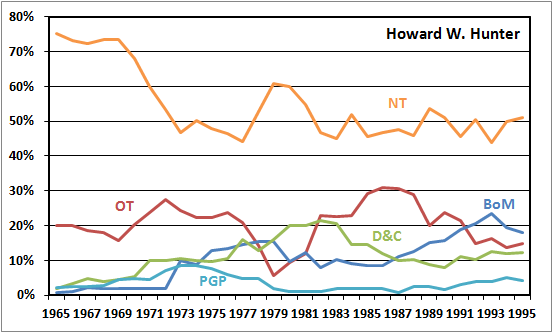
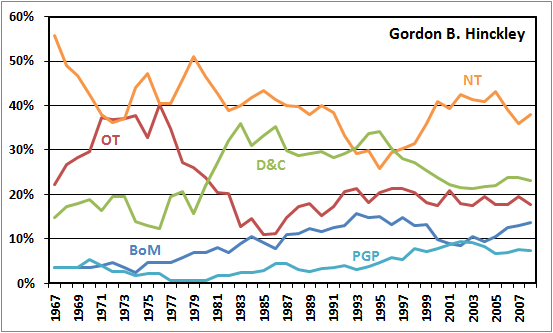 President Hinckley certainly had some variation across time, but it looks like he never got on Benson’s BoM bandwagon. Right up until the end of his life, he was still citing the Book of Mormon even less often than the Old Testament, and barely more than the Pearl of Great Price.
President Hinckley certainly had some variation across time, but it looks like he never got on Benson’s BoM bandwagon. Right up until the end of his life, he was still citing the Book of Mormon even less often than the Old Testament, and barely more than the Pearl of Great Price.
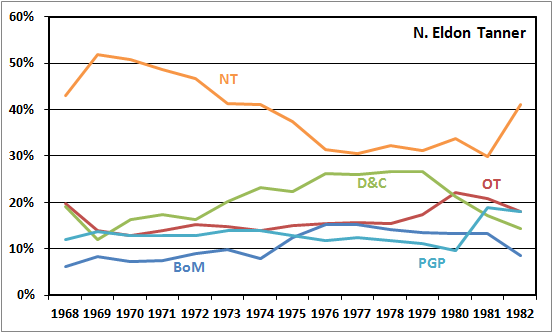
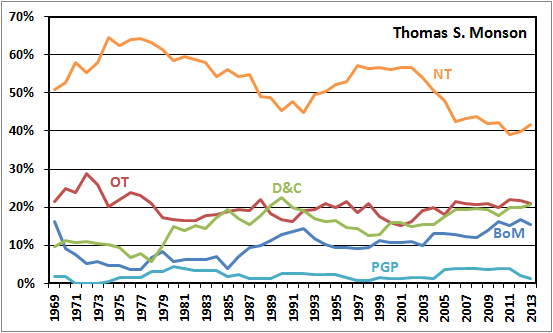
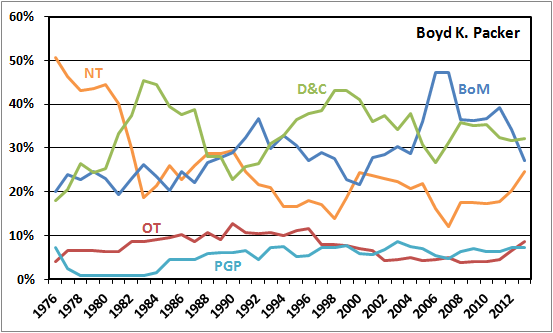 After some youthful flirtation with the New Testament, President Packer fell pretty solidly into the Ezra Taft Benson mold, going back and forth between the Book of Mormon and the D&C, but clearly preferring both to the Bible.
After some youthful flirtation with the New Testament, President Packer fell pretty solidly into the Ezra Taft Benson mold, going back and forth between the Book of Mormon and the D&C, but clearly preferring both to the Bible.
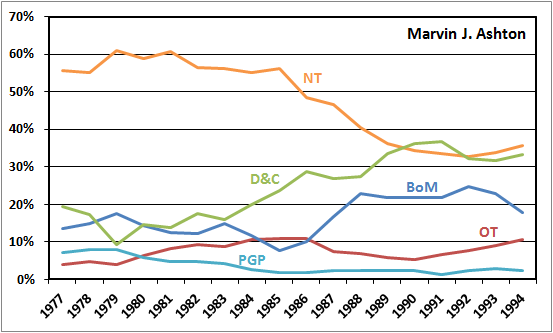
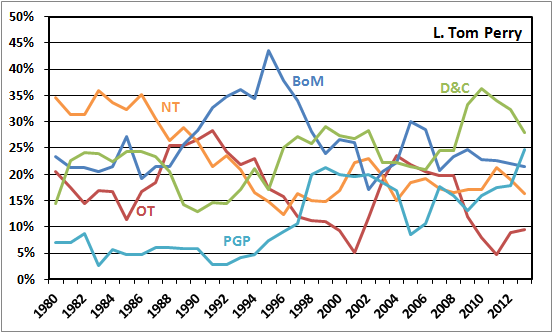 It’s really difficult to see any trends in Elder Perry’s data. He cited the New Testament the most for a while, while the New Testament’s heyday was coming to a close in Conference, then moved to the Book of Mormon along with (or following) President Benson, and recently has gone against the grain by citing the D&C the most, along with a surprisingly large number of cites of the Pearl of Great Price (given how short it is). Before gathering the data, I was actually expecting more Q15 members’ graphs to look jumbled like this rather than the more clean splits and clear preferences for one book over another that appear in so many of them.
It’s really difficult to see any trends in Elder Perry’s data. He cited the New Testament the most for a while, while the New Testament’s heyday was coming to a close in Conference, then moved to the Book of Mormon along with (or following) President Benson, and recently has gone against the grain by citing the D&C the most, along with a surprisingly large number of cites of the Pearl of Great Price (given how short it is). Before gathering the data, I was actually expecting more Q15 members’ graphs to look jumbled like this rather than the more clean splits and clear preferences for one book over another that appear in so many of them.
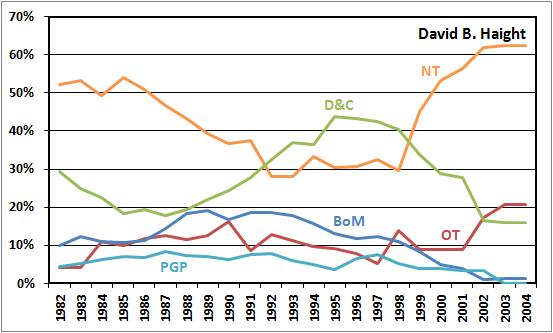
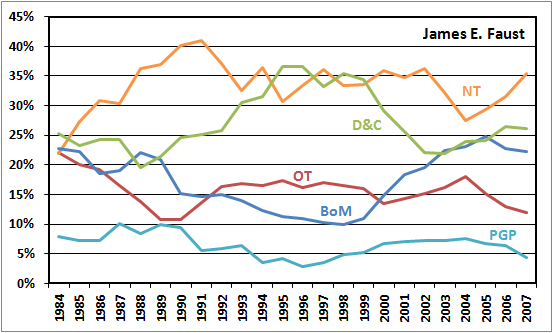
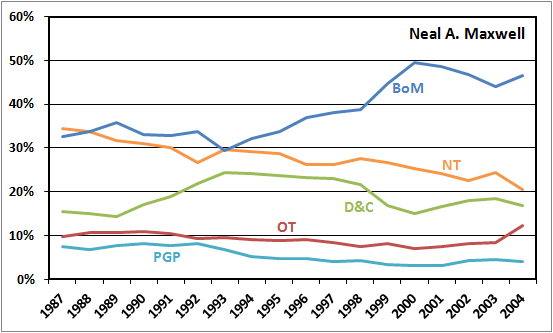
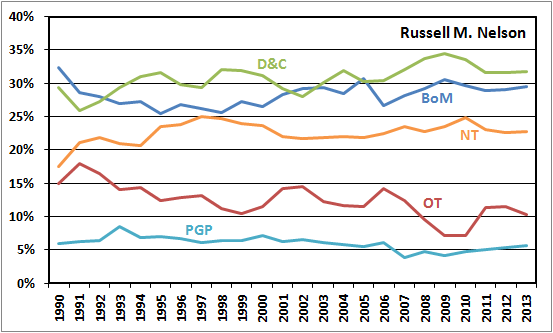 Elder Nelson is another member in the Benson mold, preferring latter-day scriptures to the Bible. He was called very close to the time that Benson became President, so perhaps he was especially influenced by him.
Elder Nelson is another member in the Benson mold, preferring latter-day scriptures to the Bible. He was called very close to the time that Benson became President, so perhaps he was especially influenced by him.
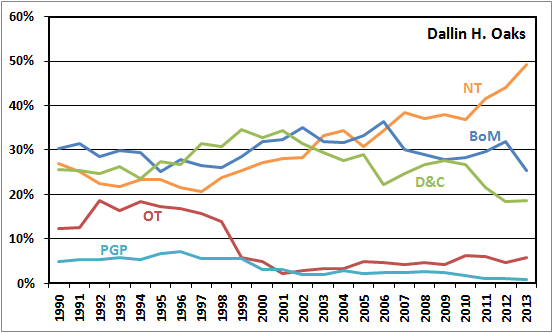
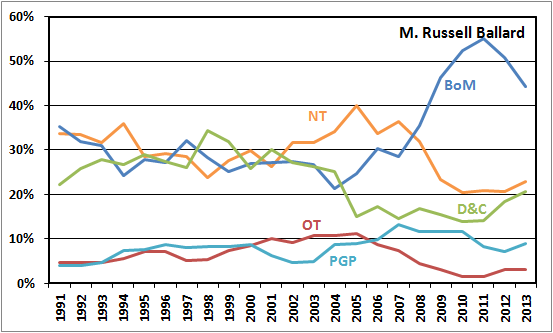
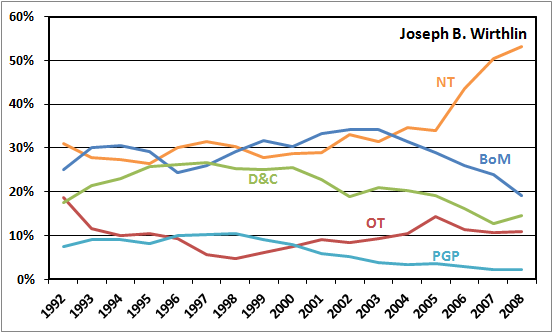 Elder Wirthlin’s late-in-life increase in citing the New Testament is interesting, especially given how consistent his preferences were before that. Dallin H. Oaks, James E. Faust, David B. Haight, and N. Eldon Tanner also had similar changes, although Elder Oaks likely has many years to live, so it will be interesting to see if his New Testament preference continues or drops off.
Elder Wirthlin’s late-in-life increase in citing the New Testament is interesting, especially given how consistent his preferences were before that. Dallin H. Oaks, James E. Faust, David B. Haight, and N. Eldon Tanner also had similar changes, although Elder Oaks likely has many years to live, so it will be interesting to see if his New Testament preference continues or drops off.
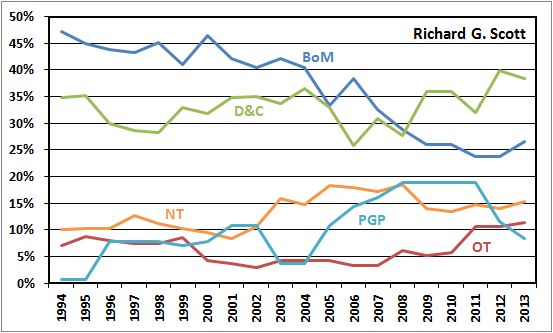 Elder Scott is in the mold of President Benson and Elder Nelson. He may show the strongest latter-day scripture preference of any of them, sometimes citing the even the Pearl of Great Price more than either the Old or the New Testament.
Elder Scott is in the mold of President Benson and Elder Nelson. He may show the strongest latter-day scripture preference of any of them, sometimes citing the even the Pearl of Great Price more than either the Old or the New Testament.
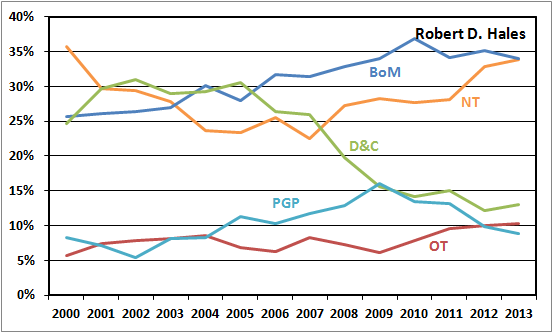
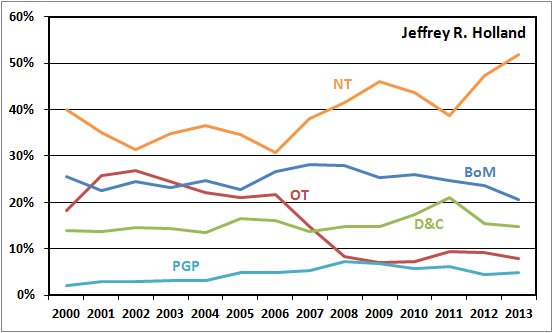 Elder Holland is an old-school New Testament guy. In the 1970s, he wouldn’t have been unusual, but now he probably is.
Elder Holland is an old-school New Testament guy. In the 1970s, he wouldn’t have been unusual, but now he probably is.
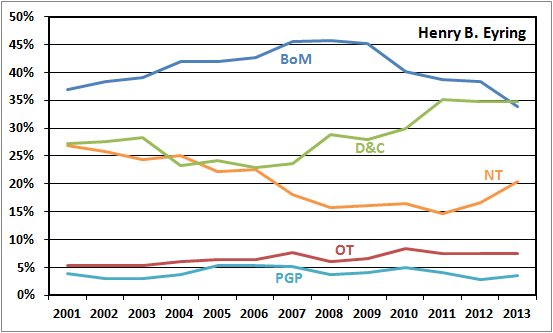 One other question that came up on the previous post was whether Q15 member’s preference for different books of scripture changed when they became President. In the following graphs, for each member in these data who became President, I show his breakdown before becoming President, and while he was President. Note that I’ve rounded calling date and talk date to the nearest year, so if a man was called as President during a particular year, I’ve counted all his talks in that year (and in subsequent years) as belonging to the time when he was President.
One other question that came up on the previous post was whether Q15 member’s preference for different books of scripture changed when they became President. In the following graphs, for each member in these data who became President, I show his breakdown before becoming President, and while he was President. Note that I’ve rounded calling date and talk date to the nearest year, so if a man was called as President during a particular year, I’ve counted all his talks in that year (and in subsequent years) as belonging to the time when he was President.
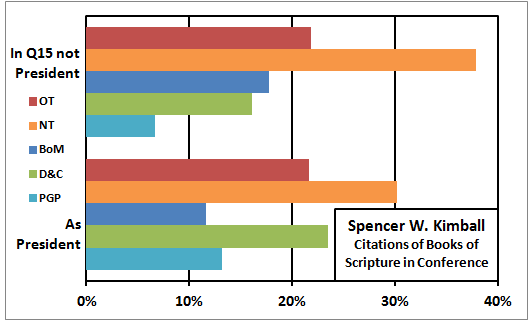 It looks like President Kimball went heavy on the D&C and Pearl of Great Price as President, relative to how much he had cited them before.
It looks like President Kimball went heavy on the D&C and Pearl of Great Price as President, relative to how much he had cited them before.
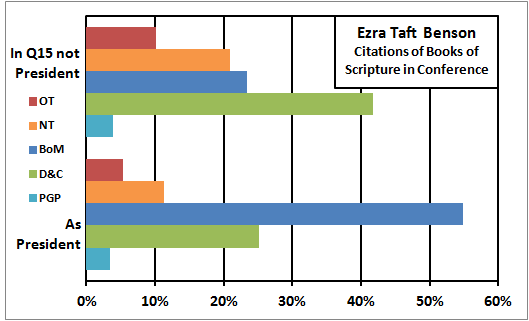 This was already pretty clear from his graph above that shows trends over time, but this highlights that President Benson cited the Book of Mormon a lot while he was President.
This was already pretty clear from his graph above that shows trends over time, but this highlights that President Benson cited the Book of Mormon a lot while he was President.
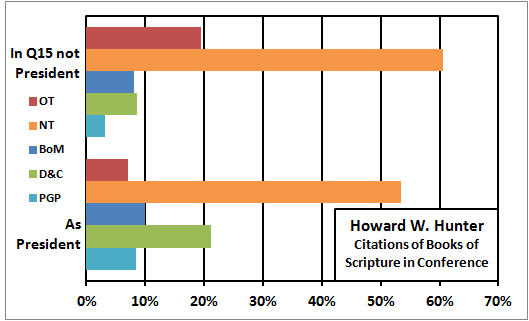 President Hunter wasn’t in his role very long, so this is based on little data, but it looks like he cited latter-day scriptures in general more as President than he had before.
President Hunter wasn’t in his role very long, so this is based on little data, but it looks like he cited latter-day scriptures in general more as President than he had before.
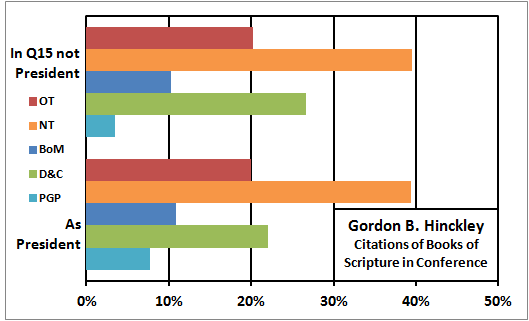 President Hinckley shows almost no change comparing before and after.
President Hinckley shows almost no change comparing before and after.
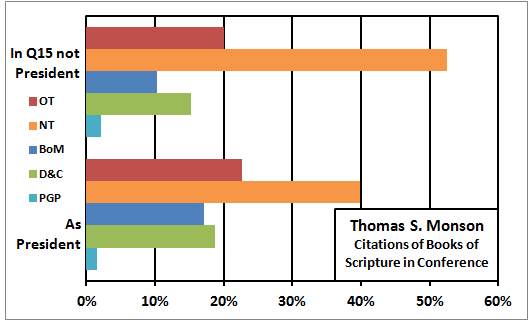 President Monson has cut down on citing the New Testament, and has gone to the Book of Mormon and D&C more than he did before he was President.
President Monson has cut down on citing the New Testament, and has gone to the Book of Mormon and D&C more than he did before he was President.
I have one final bit of analysis that might be interesting. I wanted to look at how consistent each Q15 member was in his preferences for citing different books from year to year. Hugh B. Brown, for example, looks remarkably consistent from year to year. He knew what he liked and he stuck with it. L. Tom Perry is at the other end of the spectrum, where he went from citing book the most one year, to citing another the most a few years later. To measure this consistency or inconsistency, I took each man’s overall percentages, aggregating across all the years he was in the Q15 (from the previous post), and calculated the correlation coefficient between these and his yearly percentages of citing each book. This resulted in one correlation for each year, so to summarize them, I took the average of these correlations as a measure of consistency.
The important thing to know about the correlation coefficient is that higher values indicate stronger association between yearly percentages and aggregated percentages (more consistency), and lower values indicate weaker association (more bouncing around). Its maximum value is 1. Its minimum value is -1, but because these correlations are calculated between aggregated data and the individual values that make up the aggregate data, it is difficult to imagine how the average correlations could be negative. Given this, it makes more sense to think of the minimum possible value as 0.
I’ve listed the Q15 members in order from largest to smallest average correlation. This calculation didn’t use the seven-year moving average requirement of 16 years of data, so all members from the previous post (Spencer W. Kimball forward) are included.
| Name | Avg | Name | Avg |
|---|---|---|---|
| corr | corr | ||
| Hugh B. Brown | 0.92 | Jeffrey R. Holland | 0.71 |
| Alvin R. Dyer | 0.91 | James E. Faust | 0.66 |
| Thomas S. Monson | 0.86 | Marion G. Romney | 0.65 |
| LeGrand Richards | 0.86 | N. Eldon Tanner | 0.63 |
| Neal A. Maxwell | 0.84 | M. Russell Ballard | 0.62 |
| David A. Bednar | 0.82 | Mark E. Petersen | 0.61 |
| Henry B. Eyring | 0.81 | Boyd K. Packer | 0.61 |
| Matthew Cowley | 0.80 | David B. Haight | 0.61 |
| D. Todd Christofferson | 0.80 | Robert D. Hales | 0.60 |
| Russell M. Nelson | 0.78 | Richard G. Scott | 0.60 |
| Marvin J. Ashton | 0.78 | Adam S. Bennion | 0.58 |
| Quentin L. Cook | 0.77 | Bruce R. McConkie | 0.57 |
| Gordon B. Hinckley | 0.77 | Ezra Taft Benson | 0.57 |
| Henry D. Moyle | 0.76 | Neil L. Andersen | 0.52 |
| Dallin H. Oaks | 0.74 | Spencer W. Kimball | 0.52 |
| Howard W. Hunter | 0.74 | George Q. Morris | 0.43 |
| Delbert L. Stapley | 0.72 | Richard L. Evans | 0.35 |
| Dieter F. Uchtdorf | 0.72 | L. Tom Perry | 0.25 |
| Joseph B. Wirthlin | 0.71 |
I actually chose Hugh B. Brown and L. Tom Perry as examples just looking at their graphs, so I’m happy that this measure matches up with my intuition of what looks like consistency and inconsistency.
I’m sorry that I couldn’t get to trying all the suggestions made on the previous post, but I’m always happy to hear other things you think it might be worth looking at, or any comments you have on what I’ve done here.
Any idea why BoM references dropped so hard around 1960?
Sorry, Jeff, which graph are you looking at? Or are you talking about the overall one (the second graph in the previous post)? But it doesn’t look like there’s a decline for the Book of Mormon there around 1960.
I guess I was looking more at the 50’s. Seems like prior to 1960 the BoM did get referenced all that much, but I guess that doesn’t necessarily entail a dip of any kind.
This is absolutely incredible! I love http://scriptures.lds.org and have used it for various projects, but this level of analysis is amazing. Way to go.
Thanks, John! I’m glad you enjoyed the post!